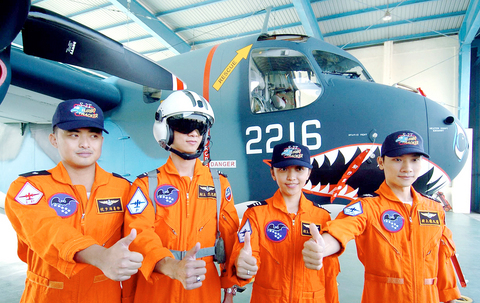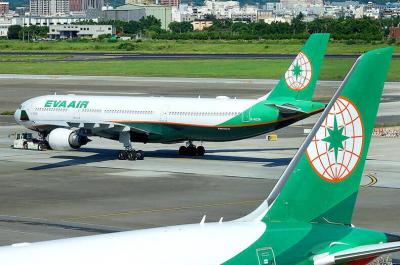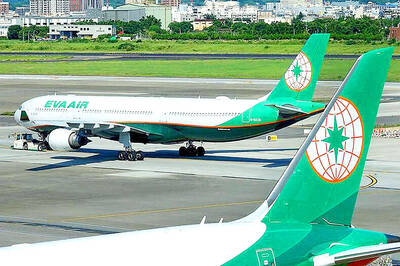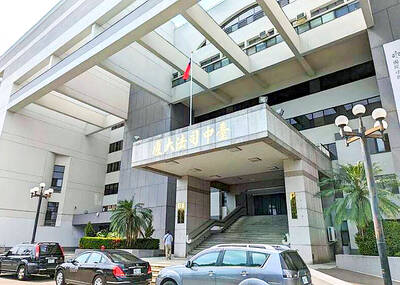The Ministry of National Defense stepped up to the plate to defend an arms procurement bill yesterday, inviting dozens of local and foreign journalists to military facilities in southern Taiwan to hear its case.
A naval official yesterday said that although China has more than 80 submarines, Taiwan's navy has only a fleet of obsolete S-2T Turbo Tracker sub-hunting aircraft that are unable to detect most of the submarines, and that was why the navy needed the more advanced P-3C Orion maritime patrol aircraft.
To give the public and the media a better understanding of the navy's anti-submarine warfare (ASW) capabilities, the navy yesterday invited reporters to visit a naval air base in Pingtung County, and displayed the S-2T aircraft and its weapon systems.

PHOTO: CHANG CHUNG-YI, TAIPEI TIMES
The navy has urged the public to support the purchase of 12 P-3Cs from the US -- one of three big-ticket items in a purchase that has been blocked for months by the pan-blue controlled legislature.
"The radar, infrared, magnetic anomaly detector and sonar systems fitted on the S-2T aircrafts to detect submarines and monitor unknown vessels are too old to efficiently complete the mission," said a commander of the S-2T force, Captain Wu Chun-wei (
He said the S-2T could only stay in the air for three hours and 20 minutes, with a top speed of 180 nautical miles per hour, which only allows them to operate in a small area.
He added that the S-2Ts have no air conditioning, no Global Positioning System (GPS) and few computer systems, and that pilots have to operate the aircraft manually -- all of which makes for a high-pressure ride for pilots.
"When S-2T pilots carry out missions in the summer, they are already sweating a lot before they get in the aircraft, but then when they fly in the winter, they must withstand the cold," Wu added.
He said most S-2T pilots consider the aircraft dangerous to fly.
In comparison, Wu said, the P-3C can stay in the air for 17 hours with a top speed of 405 nautical miles per hour.
The aircraft is equipped with a much better detection and weapon systems. And more importantly, the P-3C would be able to link to the military's command and control system, which would significantly enhance the navy's ASW capabilities.
He added that S-2Ts are unable to detect China's best submarines, such as the Ming-class, Song-class and Kilo-class submarines, as well as its nuclear-powered subs.
"We have found that China is obtaining much quieter submarines," Wu added.
He said only sustained patrols using advanced maritime patrol aircraft such as the P-3C can detect China's submarines when they are underwater around Taiwan.
He added that the navy has calculated that if it procures US P-3Cs, those aircraft could be used for more than 20 years.
Wu said the navy mainly patrols the waters northeast, southeast and east of Taiwan, and that 12 P-3Cs would be sufficient to protect the nation's waters.
Wu said that of the navy's 26 S-2Ts, only 16 of the 50-year-old aircraft are serviceable.
The navy's anti-submarine force includes 26 S-2Ts, eight 500MD helicopters and 18 S-70C helicopters. Taiwan purchased 32 used S-2Ts in 1976.

EVA Airways today confirmed the death of a flight attendant on Saturday upon their return to Taiwan and said an internal investigation has been launched, as criticism mounted over a social media post accusing the airline of failing to offer sufficient employee protections. According to the post, the flight attendant complained of feeling sick on board a flight, but was unable to take sick leave or access medical care. The crew member allegedly did not receive assistance from the chief purser, who failed to heed their requests for medical attention or call an ambulance once the flight landed, the post said. As sick

A drunk woman was sexually assaulted inside a crowded concourse of Taipei Railway Station on Thursday last week before a foreign tourist notified police, leading to calls for better education on bystander intervention and review of security infrastructure. The man, surnamed Chiu (邱), was taken into custody on charges of sexual assault, taking advantage of the woman’s condition and public indecency. Police discovered that Chiu was a fugitive with prior convictions for vehicle theft. He has been taken into custody and is to complete his unserved six-month sentence, police said. On Thursday last week, Chiu was seen wearing a white

EVA Airways, one of the leading international carriers in Taiwan, yesterday said that it was investigating reports that a cabin crew manager had ignored the condition of a sick flight attendant, who died on Saturday. The airline made the statement in response to a post circulating on social media that said that the flight attendant on an outbound flight was feeling sick and notified the cabin crew manager. Although the flight attendant grew increasingly ill on the return flight, the manager did not contact Medlink — a system that connects the aircraft to doctors on the ground for treatment advice during medical

The Taichung District Court yesterday confirmed its final ruling that the marriage between teenage heir Lai (賴) and a man surnamed Hsia (夏) was legally invalid, preventing Hsia from inheriting Lai’s NT$500 million (US$16.37 million) estate. The court confirmed that Hsia chose not to appeal the civil judgement after the court handed down its ruling in June, making the decision final. In the June ruling, the court said that Lai, 18, and Hsia, 26, showed “no mutual admiration before the marriage” and that their interactions were “distant and unfamiliar.” The judge concluded that the couple lacked the “true intention of